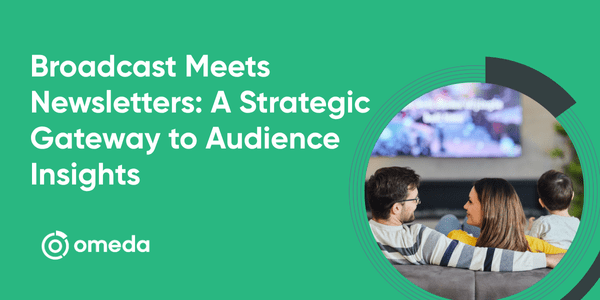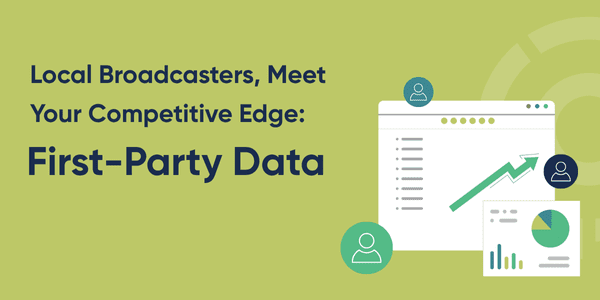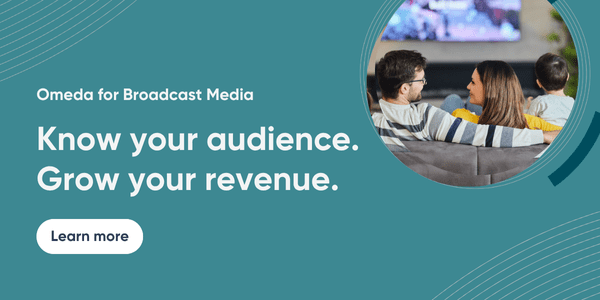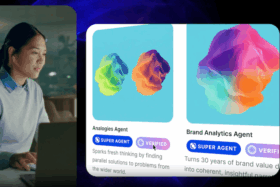| A CYNOPSIS MESSAGE FROM OMEDA |
 |
| Broadcast Meets Newsletters: A Strategic Gateway to Audience Insights
By E.B. Moss
The math is brutal for broadcasters today: anonymous ratings data offer how many and perhaps where people watched, but precious little about who those people actually are. Meanwhile, digital publishers have been swimming in rich, first-party audience intelligence for years—building detailed profiles that drive everything from content strategy to premium ad rates.
James Capo wants to bridge that gap. He’s been on the broadcast tech side, and now, as CEO of Omeda, a company with a rich history of helping publishers transform fragmented touchpoints into comprehensive audience understanding, he’s convinced that same approach can revolutionize how broadcasters and streaming services connect with their viewers.
“Publishers figured out years ago that collecting data from multiple touchpoints—website behavior, newsletter engagement, event participation—creates something like audience DNA mapping. Broadcasters are still working with demographic sketches,” he said. He’s out to deliver that DNA to the doorsteps of broadcasters now, to help them consolidate information from multiple touchpoints, hooking more engaged viewers, and ultimately more revenue, through more personalized content.
How? Omeda’s platform weaves together first party data from every interaction to build what Capo calls a “360-degree audience view.” “Broadcasters, particularly local,” he said, “have made money on linear but they’ve left digital assets, and the products underneath those brands, off the table,” even as digital-first local newsletter brands, such as Axios Local or 6AM City have gained ground.
He shared his menu for reclaiming audience connection. |
 |
| A CYNOPSIS MESSAGE FROM OMEDA |
 |
 |
| Breaking Down the Frankenstack: Simplifying Audience Management
Cynopsis: What technological challenges are preventing broadcasters from maximizing their audience data?
Capo: Media companies fundamentally have two assets: content and audience. We ask marketers to log into lots of different platforms to manage their most valuable asset, which is their audience. It’s an absolute mess—what we call a ‘frankenstack’ of disconnected marketing technologies: an email platform here, a marketing automation platform there, a CDP, a subscription management platform, a CTV platform—who is actually managing the audience? Nobody. You’ve got to build a foundational technology layer to unify that audience before you can drive any meaningful strategies.
Cynopsis: What fundamental shift should broadcasters make?
Capo: Broadcasters need to rethink their brand as an ecosystem, not just a television station. Here’s the critical problem: a viewer might watch the six o’clock news, then browse the station website and sign up for a newsletter. But there’s no unified data about an individual in a specific zip code who is subscribing to that newsletter, reading articles about, say, area sports, and who could be a prime target for specific advertising. A broadcaster doesn’t know from Nielsen ratings, for example, who is watching the programming. So, when you’re able to collect data about the person, whether it’s from a newsletter or a connected device, now you can actually convert an anonymous person to the actual person. You converted that unknown to known.
Cynopsis: Taking a page from your publishing expertise, you’ve described newsletters as a potential game-changer for audience engagement. Can you explain?
Capo: Newsletters are an undervalued asset. They offer a direct connection with the audience that most broadcasters have never had, particularly at the local level. WABC in New York, for example, is just seen as a station. In our world, WABC should be viewed as the brand, with the station, website, and newsletters as products underneath that brand.
Now imagine if ABC created a unified vertical newsletter across all its affiliates about, say, NBA content. WABC in New York, KABC in Los Angeles, and other affiliates, all have reporters writing about basketball. When someone clicks ‘I’m interested in sports’ on the WABC website, they could receive stories from across affiliates about basketball…or travel, or food—all branded as content verticals that engage the audience across their interests—all under the same brand. |
 |
| A CYNOPSIS MESSAGE FROM OMEDA |
 |
 |
| Homing in With a Simple But Powerful Solution
Cynopsis: How can unifying and leveraging first-party data transform a broadcaster’s revenue potential?
Capo: For local broadcasters, revenue typically comes from a few main sources like auto dealerships, law firms, and political advertising. Take auto, for example. If I’m a dealership in the New York area and someone from Northern New Jersey signs up for a newsletter from their local news station and enters their zip code, I now have access to useful targeting data. Pair that with browsing behavior tied to automotive content, and I’ve got a highly targeted ad opportunity. Why wouldn’t a local dealer want to advertise in a newsletter reaching thousands of people in that zip code who are actively engaging with car-related stories?
Now think about scaling that. Many large and even smaller broadcast groups have an opportunity to bring content together across their stations. They’re already producing stories in categories like sports. Rather than keeping that content siloed at the local level, they could create topic-based newsletters or websites that span multiple markets.
This opens up new ad revenue opportunities, whether sold nationally or by individual stations.
And it’s not theoretical or complicated. These approaches are already working. The workflows are simple by easily integrating the CMS or Newsroom Production System like ENPS. And with the right systems in place, content and audience data can flow easily across stations and be activated quickly.
Cynopsis: And that’s something Omeda supports?
Capo: All day long. We’re an audience engagement platform that includes email — not the other way around. We’re built to manage website data, subscriptions, and more. Most teams are juggling five or six different audience tools: an email platform, marketing automation, a CDP, and subscription systems. That’s a headache for anyone trying to actually manage an audience. We’re the foundation that brings it all together, so you can start activating everything we just mentioned.
At the end of the day, just like a broadcast production environment, this is an audience workflow problem that Omeda solves.
As a result of what we’re able to do, by implementing those products mentioned, you’re able to understand what the audience is doing in each one of those channels. And that’s where the magic happens.
We’re an enterprise solution, not like an email hosting platform where we throw you the keys and we say, ‘See you later and good luck.’ We’re constantly working with our clients on strategies and ideas, but they’re the ones pushing the buttons. Our goal is to help teach clients to fish, with the tools and services that Omeda provides. |
 |
| A CYNOPSIS MESSAGE FROM OMEDA |
 |
 |
| The Future is a Fragmented Audience Strategy
Cynopsis: Looking ahead three to five years, what should media leaders do?
Capo: If you haven’t started defining and owning your first-party audience data strategy, you’re already late…Media companies have been leasing their audiences, not owning them. The major social platforms have turned off traffic referrals. Google and Facebook don’t care about pushing their audience to your properties anymore. …The rise of generative AI and zero-click searches means people can get answers without clicking through to websites. This is driving an urgent need for media companies—especially broadcasters—to develop a direct connection with their audience.
Again, look at the newsletters, like 6AM City, or Patch and others that are moving into local, while there are brands like WGN that have been in the local community for decades and are completely giving the newsletter local brand over to some of these startups by not creating an environment outside of linear. They need to understand the critical importance of direct audience connection and develop products and services with a one-to-one audience connection to have a fragmented audience strategy. That’s what our team and solutions can help them achieve.
Radical but Logical Imagination
For an industry accustomed to broad demographic buckets, a more granular approach to audience data represents a fundamental shift in how media companies can understand and serve their viewers.
Luckily, Capo is experienced in multiple media platforms. He began his career in the broadcast group of the Associated Press, working on an electronic news production system. He then transitioned into B2B digital media at Cygnus Business Media, followed managing digital operations across six platforms for Cynopsis’s own parent company, Access Intelligence where he applied Omeda tactics directly.
Given his background and clear vision to offer media platforms more ways to move beyond a sea of anonymous viewers, he’s aiming to help others see how to connect the dots to engage with more well-defined audiences. |
|












